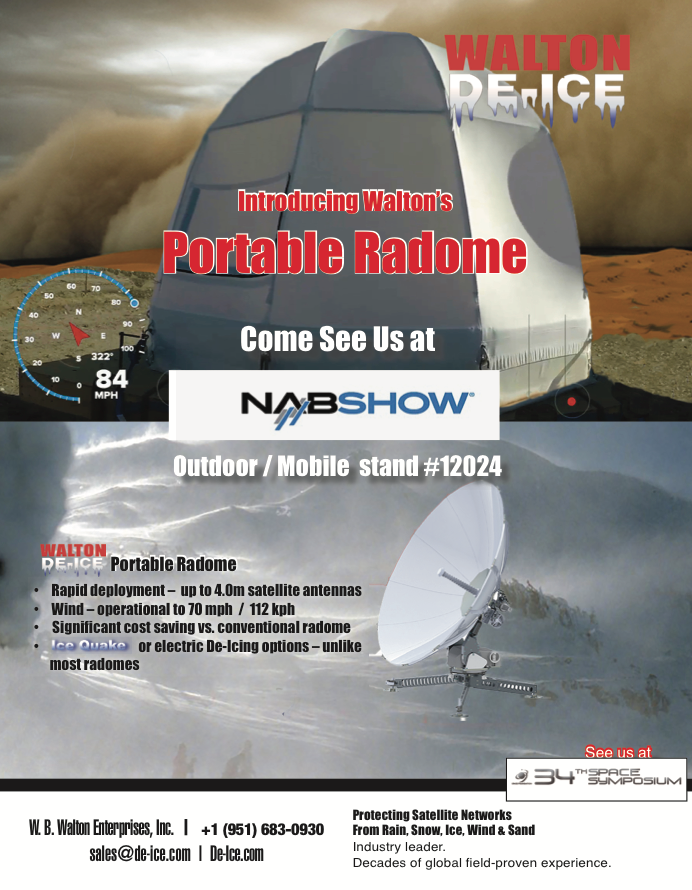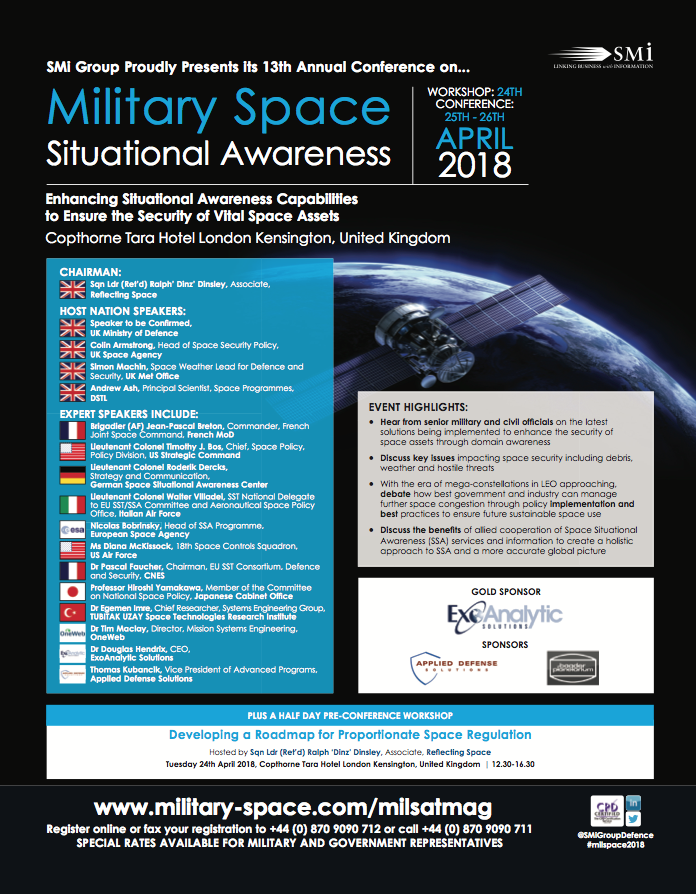Whether the B-9 Class M-3 General Utility Non-Theorizing Environmental Control Robot was known as “Robot,” or “B-9” or the “Robinson Robot,” the automaton was a valued member of this space faring family who were widely celebrated during their “Lost in Space” TV series. The program that was produced by famed director and producer Irwin Allen ran from 1965 to 1968.

Why was “Robot” so appreciated (in most cases) by the Robinson family? Basically, for the unit’s ability to assist them with their daily work as well as in the detection of threatening conditions. “Danger, danger!” Robot would call out. Its arms and hands would wave up and down in a fashion that could only be surmised as frantic, accompanied by an impressive light display within the robot’s transparent “head.”
“Danger, danger” is definitely the case when considering the disastrous, debilitating effects of orbital debris as well as the threat of ASATs (AntiSATellite) upon on orbit military, agency and government (MAG) satellites. Far beyond simply disconcerting, this threat is downright intimidating for those whose thought processes range beyond deciding who to vote for as the next song or dance contest “wannabe star.”

John Rood, the U.S. Undersecretary of Defense for Policy.
Regarding ASATs and space-based conflicts, during a recent U.S. House Armed Services subcommittee hearing to examine the role of strategic forces, John Rood, the undersecretary of defense for policy, stated that preparations are being initiated by the Pentagon should an attack be conducted by adversary states upon U.S. space systems
and satellites.
Rood stated, “And [DoD] space capabilities are critical for effective deterrence, defense and force projection capabilities. Due to the critical importance of these assets, the national security strategy states, ‘any harmful interference with, or an attack upon critical components of our space architecture that directly affects this vital U.S. interest will be met with a deliberate response at a time, place, manner and domain of our choosing.”
If readers do not believe that ASATs, or orbital debris are credible threats to the security of the nation, then follow the money. Rarely do nations invest in offensive and defensive technologies if a threat is merely smoke and mirrors.
Last year, the U.S. committed $11.4 billion in, what Mr. Rood called, “more resilient defendable space architecture,” technology and capital funding.
This year, that amount increased to $12.5 billion.

U.S.A.F. General John Hyten, Commander, U.S. Strategic Command.
The commander of U.S. Strategic Command, U.S. Air Force General John Hyten and the Pentagon requested $24 billion to counter any and all adversarial forces that target satellites and other space architectures. The budget submission also included a financing request for the replacement of U.S. space-based assets, should they become disabled or destroyed as the result of an attack upon them.
How could a defense currently be mounted against such assailants? General Hyten’s Strategic Command wants to enhance an already-in-place anti-missile missile defensive strategy. Currently in Alaska there are 44 anti-missile interceptors on duty, with an additional 20 such weapons forthcoming. Two additional bases are under consideration, including one on the East coast.
Could such weaponry be used to counter attacks in space? As of this writing, probably not, as the main directive for these defensive weapons would be to counter missile attacks on the U.S. and Allies land-based strategic assets. However, studies and planning are currently believed to be underway to enhance U.S. land-based capabilities to enable them to defend against aggressor space attacks upon valued orbital satellites and other assets.
The best defense is a solid offense — U.S. military commands and R&D agencies are believed to be engaging in the study and implementation of technologies that could be mounted in space or on Earth that would attack aggressor forces and their command structures via direct energy weapons (lasers), cyber attacks, advanced jamming capabilities and other
hush-hush technologies.
Russia and China, as well as a variety of additional aggressor states, are already engaged in ASAT development — according to estimates by the U.S. Joint Staff Intelligence Directorate, known as J-2, such weaponry should be operable and in place in a couple of years, all with the aim of incapacitating or destroying LEO satellites.
According to a DoD report, the People’s Liberation Army (PLA) is acquiring a range of technologies to improve China’s space and counter-space capabilities. China demonstrated a direct-ascent kinetic kill anti-satellite capability to LEO when it destroyed the defunct Chinese FY-1C weather satellite during a test in January of 2007.
A People’s Liberation Army (PLA) analysis of U.S. and coalition military operations reinforced the importance of operations in space to enable ‘informatized’ warfare, claiming that “space is the commanding point for the information battlefield.” PLA writings emphasized the necessity of “destroying, damaging, and interfering with the enemy’s reconnaissance...and communications satellites,” suggesting that such systems, as well as navigation and early warning satellites, could be among the targets of attacks designed to “blind and deafen the enemy.”
That same PLA analysis of U.S. and coalition military operations also states that “destroying or capturing satellites and other sensors… will deprive an opponent of initiative on the battlefield and [make it difficult] for them to bring their precision guided weapons into full play.”
In the 2017 DoD Annual Report to Congress — “Military and Security Developments Involving the People’s Republic of China 2017”
(www.defense.gov/Portals/1/Documents/pubs/2017_China_Military_Power_Report.pdf) — under the subhead Space and Counterspace Capabilities, the report stated that China’s space program continues to mature rapidly. “China also continues to develop a variety of counterspace capabilities designed to degrade and deny the use of space-based assets by adversaries during a crisis or conflict.”

Launch of a Dong Ning-2 Rocket by China.
In addition to the aforementioned January 2007 test, that nation also conducted an ASAT test in May of 2013 that was launched from China’s Xichang Satellite Launch Center, located in southwest China. The purported mission was to investigate “energetic particles and magnetic fields in the ionized startup and near-Earth space.”
Although not stated publicly, officials in the U.S. highly doubted the Chinese statement and believed this was merely a public relations cover for an ASAT test using a Dong Ning-2 (DN-2) rocket, which reached an altitude of 18,641 miles (30,000 km.). Unnamed U.S. officials at that time indicated the DN-2 would have the capability to effectively ram, and thereby destroy, strategic communication, navigation, or intelligence satellites. A successor vehicle, a Dong Neng-3, was also apparently launched on October 30 in 2015.
Another Chinese weapon alleged to being tested is a land-based, high power laser generator that can target satellites and will be able to incapacitate electro-optical satellites as well as interfere with Synthetic Aperture Radar (SAR) satellites.
China is unifying their cyber, Electronic Warfare (EW) and space capabilities through the ongoing development of that nation’s Strategic Support Force (SSF), which was created in 2015 to concentrate on additional offensive capabilities and mobility for the PLA’s cyber and space ops. There have also been bilateral military exercises between Russia and China with possible technological exchanges between the two nations.
A technology that is being diligently worked on by the Chinese military-industrial complex is what is known as “satellite ghost imaging.” This technology involves the development and build of optical cameras that can peer through most obscuring elements, such as clouds, negating most environmental factors that would normally block imaging capture by satellites. Don’t expect China to be the only nation digging into
this technology.
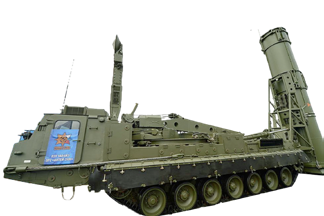
Consider — China currently possesses the most satellites in orbit behind the United States. Many of these satellites are covert in nature — those platforms may well carry the capability to attack opponent satellites. China has already deployed two ASAT missile systems which has plans to build even more advanced, ground-launched, ASAT weapons.
Contemplate the wealth of information satellites delivered to U.S. and Allied forces… satellites are a force multiplier in that they manage critical comms between commanders and the battlefield, collect intelligence, surveillance and reconnaissance (ISR) data, handle command and control (C&C) missions, steer offensive weaponry to targets, defend state-owned assets and constantly update damage assessments for weapon re-targeting. As opponent states have stated, without operational satellites, the ability for rivals to defend their resources and to attack others is substantially reduced.
Adding additional fuel to the ASAT fire, the 2017 DoD report indicated that Chinese “space operations will probably form an integral component of other PLA campaigns and serve a key role in enabling actions that counter third-party intervention. China is seeking to utilize space systems to establish a real-time and accurate surveillance, reconnaissance and warning system, and to enhance C2 in joint operations. These advancements include the Beidou navigation satellite system and space surveillance capabilities that can monitor objects across the globe and in space.”
Russia is also actively engaged in ASAT development, with a believed focus being on their A-60 and Nudol systems — the former can blind a satellite and the latter is a ground-based, direct ascent missile — the solid propellant launch vehicle for this ASAT has been tested at least three times from the Russian Plesetsk launch facility, with one of these tests successful. Information regarding the number of follow-up launches is unknown as of this writing.
Bring GPS/GNSS/GLONASS/IRNSS/Beidou navigation satellites (navsats) into the discussion and successful ASAT weaponry assaults on those assets would have an immediate affect on the civilian population, as well. Their unavailability would drive much of the populace into a severe state of dismay… dependence upon navsats for civilian and military forces has become more than just a “nice to have” — there is a total dependence upon these satellites for much of what all accomplish each day to earn a living, communicate with others, defend a nation and to simply enjoy life.

Dan Coats, the Director of National Intelligence.
Dan Coats, the Director of National Intelligence, stated, “We assess that Russia and China perceive a need to offset any U.S. military advantage derived from military, civil, or commercial space systems and are increasingly considering attacks against satellite systems as part of their future warfare doctrine.” Simply stated, such commentary should offset any dithering or complacency within the legislative branches of the federal government as to the funding to support the requested offensive and defensive space assets so crucial to the nation’s survival.
Coats additionally warned Congress that Russia already possesses a diverse suite of capabilities that would “affect satellites in all orbital regimes.” That nation would be able to target and totally disrupt U.S. satellite functionality with an airborne laser.
There are assets that certainly are being considered for use today to offset attacks on U.S. or allied state satellites. The U.S. Air Force’s highly secretive solar-powered X-37B autonomous orbiting vehicle, built by Boeing’s Phantom Works division, is designed to fly at altitudes ranging from 110 to 500 miles (177 to 805 km.).
The X-37B could potentially carry technologies for offensive and defensive operations in space. This craft, as of this writing, has already completed four, secretive, orbital missions and may well have conducted more flights than are publicly known. The U.S.A.F.’s 3rd Space Experimentation Squadron, based at Schriever Air Force Base, handles mission control for the X-37B, which is managed by the U.S.A.F.’s Rapid Capabilities Office.
With the X-37B’s payloads all classified, the craft’s 7 feet long by 4 feet wide (2.1 x 1.2 meters) dimensions could certainly be capable of packing small to medium sized weaponry designed to contradict invader assets — weight would certainly be an issue to be overcome — the X-37B is boosted vertically with the assistance of a launch rocket and lands back on Earth on a runway. And lest all forget, the U.S. has already proven its ability to interdict a satellite — in 2008, a National Reconnaissance Office (NRO) satellite was intercepted by a modified U.S. Navy SM-3 anti-missile and destroyed.
During a recent House Armed Services Committee hearing, General Hyten explained that in order to secure space, teammates are needed in order to share intelligence and assets. To that end, In 2017, the Joint Interagency Combined Space Operations Center (JICSpOC) was renamed the National Space Defense Center — initial operational capabilities should be in place by November of 2018, with full operation by the close
of 2018.
When the U.S.A.F.’s Space Enterprise Vision (SEV) was announced in April of 2016, a press release from Air Force Space Command (AFSPC) based at Peterson Air Force Base in Colorado included comments from General Hyten, who said the organization will become, “a centralized hub for operational planning and tasking,” adding, “SATCOM systems are key to our continued strategic posture in space. We must expand international SATCOM partnerships.”
The General added, ”In the recent past, the United States enjoyed unchallenged freedom of action in the space domain. Most U.S. military space systems were not designed with threats in mind, and were built for long-term functionality and efficiency, with systems operating for decades in some cases. Without the need to factor in threats, longevity and cost were the critical factors to design and these factors were applied in a mission stovepipe. This is no longer an adequate methodology to equip space forces.”
The SEV accounts for the increasing threat to space systems and provides a vision for how the U.S. Air Force should build a force responsive to that threat. The vision describes an integrated approach across all space mission areas, coupling the delivery of space mission effects to the warfighter (such as communications, positioning, navigation and timing, missile warning, and weather data) with the ability to protect and defend space capabilities against emerging threats.
Consistent with U.S. National Space Policy, the vision enhances U.S. space forces’ ability to deter others from interference and attack, defend our space systems if deterrence fails and contribute to the defense of allied space systems.
“The future space enterprise will maintain our nation’s ability to deliver critical space effects throughout all phases of conflict,” Hyten said. “Operating as an enterprise as opposed to a set of independent platforms improves resiliency and is critical to the ability to survive and deliver effects in a contested environment.”
Since the study was commissioned, AFSPC and the National Reconnaissance Office (NRO) have worked together to incorporate principles of the NRO vision as well, with additional work ongoing to fold in the remaining facets of the Defense Departments’ space capabilities and the key linkages with the intelligence community.
“Ultimately, the SEV (Space Enterprise Vision) must incorporate requirements from across the U.S. government’s space enterprise,” Hyten said. “By incorporating interagency space visions, the SEV will fold requirements into a single-enterprise vision that addresses the unique needs of each agency.”
To guide the development of this future enterprise, the SEV proposes using a new optimizing concept called “resilience capacity” to characterize and evaluate space capabilities.
Resilience capacity will measure how well space enterprise forces can respond to the full range of known threats, and how quickly they can adapt to counter future threats, while continuing to deliver space effects to joint and coalition warfighters. It will replace the traditional “functional availability” metric used for decades to plan and manage individual constellations, but which does not account for emerging threats.
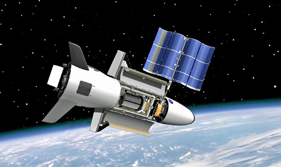
The U.S.A.F.’s reusable X-37B
“The future space enterprise will be built by changing how we architect, develop, acquire, and operate our space systems,” Hyten added. “Going forward, we will rigorously focus on a clear definition of warfighter requirements with programs acquired using greater horizontal integration across the space enterprise. We will also move toward shorter program life cycles and decreased time between constellation updates, which improves the availability of new technology on orbit.”
In the U.S., Space Situational Awareness (SSA) is taking a front seat as a key investment by the DoD, with implementation, for the most part, occurring within the U.S. Air Force. The ability to detect and track smaller objects is a major goal of the space fence program. This should enhance space systems survivability.
Bringing on orbit satellite servicing spacecraft into the picture, if a friendly satellite can be captured, refueled and otherwise repurposed by these spacecraft, certainly their ability to immobilize or otherwise negate an “unfriendly” satellite is within the realm of reason. China is driving development of on orbit servicing and maintenance systems, as is the United States and other nations — is all of this development strictly for peaceful satellite repurposement?
When all of the hyperbole and all of the chatter is reduced to the basics, the realization should dawn that nearly any ballistic missile can be programmed to become an ASAT weapon.
Space Servicing and More…
SSL, a Maxar Technologies company (formerly MacDonald, Dettwiler and Associates Ltd.), is leveraging advanced space architectures and systems developments to assist the U.S. Air Force Space and Missile Systems Center (USAF—SMC) with investigations into new enterprise-level solutions to bring solutions to space resiliency concerns.
This study is expected to accelerate crucial technologies for future missions as identified within the SEV, which recognizes the increasing threat to space systems and provides an overarching vision for how the USAF should respond. In addition to enabling a more affordable and resilient national security space enterprise, the SEV shapes future space architectures that are intended to protect and defend our nation’s space capabilities against emerging threats.
SSL is working across the U.S. Department of Defense (DoD), civil, and commercial space communities on several leading-edge programs and studies that are expected to help U.S. government agencies define next-generation space technologies. These include the Payload Orbital Delivery System (PODS), a rideshare technology scheduled for its inaugural launch on an SSL-built satellite in 2018, Dragonfly robotics for on orbit assembly, and sophisticated technologies for on orbit GEO and LEO satellite servicing.
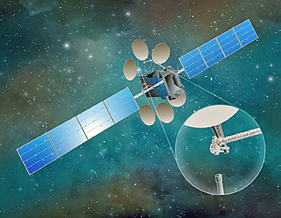
SSL’s Dragonfly spacecraft.
In early December of 2016, NASA selected SSL to build a spacecraft for the demonstration Restore-L mission to repurpose the U.S. Geological Survey’s Landsat 7 EO satellite in 2020. The SSL spacecraft will provide the power, communications and propulsion for the mission.
In February of 2018, the company received an award from the Defense Advanced Research Projects Agency (DARPA) to work on the Robotic Servicing of Geosynchronous Satellites (RSGS) program to bring their satellite bus and refueling technologies to this project, while DARPA will produce the actual servicing payload as well as launch
the satellite.
SSL is also assisting the U.S.A.F. develop a secure interface for hosting government payloads on commercial satellites, designing power and propulsion systems for NASA’s deep space gateway, and developing concepts for advanced satellite communications (SATCOM).

Richard White, President, SSL Government Systems.
Richard White, the President of SSL Government Systems, noted that national and global security depends on the operational continuity and resilience of the nation’s space assets and the company is honored to contribute concepts based on the firm’s depth of experience to help accelerate the innovation needed for the U.S. Air Force to achieve their Space Enterprise Vision. SSL delivers proven commercial practices to design and build end-to-end space systems that can improve resilience, cost, and speed for government customers and help protect the quality of life for us all.
Maxar, in June of 2017, created a new subsidiary to handle such space servicing work — Space Infrastructure Services (SIS) — to develop
on-demand robotic service spacecraft that will be available for missions starting in 2021 and beyond. With SIS, the company claims satellite operators will be able to improve on orbit resilience and have unprecedented flexibility for satellite fleet management.

Orbital ATK’s MEV-1 spacecraft.
The SIS service arrives at a GEO spacecraft that requires the spacecraft’s assistance, completes the assigned tasks within a few days and then redeploys for pre-scheduled and emergency call-up servicing — that seems similar to roadside assistance, except this is in space.
The SIS services are insured and payment is not due until a successful service has been completed. Plus, SIS states the satellite being serviced can continue to operate during most of the robotic servicing procedures. The SIS servicer will be compatible with government and commercial spacecraft — even those not designed to be serviced in space. (www.spaceinfrastructureservices.com/)
Another company entering this market segment is Orbital ATK’s SpaceLogistics subsidiary, which was established to provide cooperative on orbit satellite life extension and maneuvering services to GEO operators via the firm’s Mission Extension Vehicle (MEV), which is based on Orbital ATK’s GEOStar 3 bus — the unit docks with a customer’s existing satellite to provide the propulsion and attitude control to extend that satellite’s life.

David W. Thompson, Orbital ATK’s President / CEO.
During a recent trade show, President and CEO, David W. Thompson and President Tom Wilson introduced a new robotic servicing sytem that will, according to their information, enable the company to expand their customer base with advanced mission capabilities in this emerging market segment.
This new system is comprised of two products — the Mission Extension Pods (MEPs)™ and Mission Robotic Vehicles (MRVs)™. The former is an extral propulsion modules that attaches to, and provides up to five years of, orbital life extension for aging satellites that are running low on fuel, but are otherwise healthy. While the primary application of the MRV is to transport and install MEPs or other paylods on customer satellites, the spacecraft will also offer space robotic capabilities for on orbit repairs and similar functions.
Tom Wilson noted that, while Orbital ATK’s space logistics technology roadmap does not directly identify orbital debris as a primary market, the company’s roadmap does support some of the challenges of orbital debris mitigation. He added, “For example, our initial MEV can be used to “tow” disabled, but stable, satellites from the GEO orbits to the GEO graveyard; or return them to service depending on the disability. The company’s next-generation system that has just been announced incorporates robotics that will allow for detailed inspections, simple repairs, and installation of augmentation payloads which may enable disabled satellites to return to service.

Tom Wilson, Vice President and General Manager,
Orbital ATK.
“Looking into the future, we are developing generic interfaces for future spacecraft that will greatly enhance the ability to repair, maintain and augment capabilities that will enable these spacecraft to return to service rather than become space junk; and the robotics will provide the ability to capture unstable spacecraft for removal from operational orbits.”
Wilson then said, “The introduction of MEPs allows us to offer a complementary service alongside the company’s MEVs to meet the industry’s needs by providing low-risk, low-cost station-keeping for geosynchronous satellites of all types. Orbital ATK always aimed to expand the company’s fleet to provide a wide variety of space logistics services, and the MEV, MEP and MRV products give customers the option to select exactly the kind of life extension or in-space repair they may need.”
A third competitor entering the fledgling satellite servicing sector is Effective Space (www.effective.space/). The company recently signed a contract with launch provider ILS (beta.ilslaunch.com/) to push two of their SPACE DRONE™ spacecraft into orbit in 2020 to handle the station-keeping, relocation, de-orbiting, orbit correction and incline correction and ‘bringing into use (BIU) needs of the target satellite.’
The SPACE DRONE weighs 400 kg. and possess a universal, non-intrusive docking system that will rendezvous and then dock to a geostationary host satellite. The SPACE DRONE will then use electric propulsion to support the satellite’s station-keeping and attitude-control maneuvers.
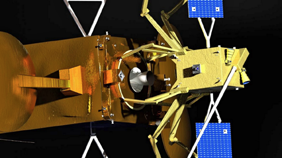
Artistic rendition of Effective Space’s SPACE DRONE™.
The ILS will employ their Proton Breeze M launch vehicle to send the two satellites to their destination. The rocket has a lift capability of 6.3 metric tons for satellites heading to GTO launches and 3 metric tons for GSO destinations. Two payload fairings are available — 4.35 meter and 5.2 meters, enabling the launch vehicle to encase single or multiple satellite payloads.

Arie Halsband, Founder and CEO of Effective Space.
Arie Halsband, the Founder and CEO of Effective Space, said, “Launching our first two SPACE DRONE™ spacecraft into a geostationary orbit is part of our strong commitment to our first customer, meeting mission timeline and ensuring smooth transition into a life-extension service. Due to the attractive economics, extending existing assets in space is something that is gaining significant traction in today’s market. With that in mind, the announcement of this launch, utilizing the performance of the Proton Breeze M vehicle, is an important milestone for a rapidly developing market. ILS worked with us to arrive at a reliable, high performing, cost-effective solution for our business. We look forward to our continued work with ILS and Khrunichev to propel this exciting phase of our company forward.”

Kirk Pysher, President, ILS.
The President of ILS, Kirk Pysher, added, “The company is focused on serving the satellite industry with flexible, and affordable launch solutions and our agreement with Effective Space is a perfect example of that. The performance of the Proton Breeze M vehicle to deliver the SPACE DRONE™ spacecraft directly to geostationary orbit combined with our decades-long history of launching dual or multiple spacecraft at one time, makes it a natural fit for Proton to deploy their spacecraft. This combination of performance and experience will enable Effective Space to realize their mission objective in the most expedient and effective way possible.”
Debris Dilemma
In addition to the ever-increasing threat posed by ASATs, orbital debris is of major concern to military, government, agency and civilian entities. Orbital debris is defined by NASA as “any man-made object in orbit about Earth that no longer serves a useful purpose, including spacecraft fragments and retired satellites.” Toss in meteoroid particles, which can range in size from as large as 10 meters to clots of dust, and space is a dangerous arena for satellites and other spacecraft.

Chris Blackerby, the COO of ASTROSCALE.
Chris Blackerby, the COO for ASTROSCALE PTE. Ltd., offered the following regarding the importance of orbital debris awareness and removal.
He said, “One of the most concerning environmental issues for humanity can be found far above the surface of the Earth. The presence of orbital debris is a persistent threat not only to the handful of astronauts who live on the International Space Station, but to the billions of us on Earth who are increasingly reliant on satellites for all aspects of our daily lives.
“There are currently more than 100 million objects in orbit that are under 1 cm. in diameter, 22,000 of which are over 10 cm. More than 99 percent of these objects are uncontrollable debris that could cause the destruction of the ISS and thousands of active satellites of all types — security, civil and commercial. Though the chance of a mission-ending collision from a piece of debris on any given active satellite is still unlikely, if an impact did occur it could destroy an on orbit asset instantly and the effects on military activities as well as our daily life would be devastating.
“As launch and satellite development costs continue to decrease we find ourselves on the cusp of a democratization of space that will fundamentally alter the next space age, creating multiple opportunities for enhanced military capability and societal benefit while also significantly increasing risks of collision. The congested and contested orbital environment is only going to get more crowded in the years and decades to come and an effective and economical solution for tracking and removing debris is a necessity.”
ASTROSCALE is a Singapore-based satellite services company that was founded in 2013 with the objective of developing innovative solutions against the growing number of space debris. The company’s mission is to actively contribute to the sustainable use of the space environment by developing scalable and innovative on-orbit technologies, in order to safely remove the most threatening debris in orbit.
In addition to spacecraft debris removal technologies, Astroscale is invested in providing debris monitoring and tracking capabilities. The company has conducted accurate research to collect essential data on small-sized debris that cannot be tracked using the existing ground-based technologies. With headquarters located in downtown Singapore, and a manufacturing facility in Tokyo, the company is actively preparing for its first two missions, IDEA OSG 1 and ELSA-d.
(www.astroscale.com).

Artistic rendition of China’s Tiangong-1 space station, now in free fall.
The effect of orbital debris on Earth could not be more clearly witnessed than with the upcoming free-fall of the Chinese 8-1/2 ton Tiangong-1 space station. Launched in 2011, this was China’s first prototype space station and includes hydrazine on board, which has a Group B classification from the Environmental Protection Agency (EPA — www.epa.gov ) as a probable human carcinogen.
Between 10 and 40 percent of the space station is expected to survive re-entry burn through the Earth’s atmosphere, with the German Space Debris Office calculating impact between March 24 to April 19 (as of this writing).
The European Space Agency’s (ESA) Space Debris Office has reported that the fragments of the space station should arrive in locations between 43 degrees North and 43 degrees South, which places the southern sections of northern states in the U.S. as well as several European countries, the Middle East, New Zealand and Tasmania in Australasia as well as southern Africa and South America, as zones where impact(s) could occur
(www.esa.int).
Thanks to a forecast by the Aerospace Corporation (https://www.aerospace.org), falling fear factors should be reduced as that company offers the information that the odds of any individual being struck by the space station’s debris is approximately one million times less than the odds of winning a Powerball jackpot. Additionally, there have been no recorded incidents of anyone on Earth ever being struck by space debris. Everyone hopes this record is maintained while what is remaining of Tiangong-1 comes home.
Food for thought — could orbital debris be “weaponized?” Certainly worthy of consideration… give a significant piece of orbiting debris or a significantly-sized meteoroid a “nudge” in the correct direction, following careful calculations, and the impact upon a target would be similar to that of a missile strike — quite significant.
Works in Progress
Several companies around the world are developing advanced space defense capabilities for defense and offense — all of the words and all of the treaties pale into insignificance when learning of the capabilities and power of who can do what to whom in space… and when.
Over the past couple of years, the U.S. and her allies are starting to realize the dangers inherent in ignoring the threat of ASATs and debris, while aggressor states continue their advancements in these crucial areas of space control... being late to these endeavors could well be deadly.
As U.S. President Trump stated during his 2018 State of the Union address, “In confronting these dangers, we know that weakness is the surest path to conflict, and unmatched power is the surest means of our defense.”


